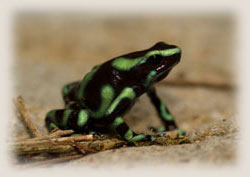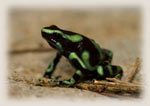Frogs for the beginner

At this page you will find alot of information about frogs that is easier for the beginner to start with. Examples of species that will be presented here is: auratus, leucomelas, tinctorius, yellow ventrimaculatus, imitator "nominat".
At this page you will find alot of information about frogs that is better for the beginner to start with, mostly since some species is easier to keep alive than others. This doesn't mean in any way that these species is more boring or dosn't look as nice as the others, some of the frogs I like the best myself is among the frogs I recomend as good beginners frogs. The reason that these frogs is easier is because it's easier to create a good artificial copy of their natural habitat or that their habitats is very varied and the frogs is more tolerant and hardy against things that can be totally wrong with some species. They are also alot easier to learn to see problems with, mostly since they are bigger in size than for example thumbnails species. Another benefit is that as long as you stay with the more normal morphs it's frogs with a relative low price. Here is some more information about some good beginners frogs:
Dendrobates leucomelas
This is beutiful yellow and black frog that is the first chooise for me if people want me to pick out a beginners frog. Why? Well, it's one of the most beutiful frogs among the dartfrogs and it is also mostly a very un-shy frog. It's very common that it sit in my vivariums in the front an beg for more food. They can also be held in quite big groups and where it is easier to see diffrent kinds of dominating fights, females trying to get male to follow and so on. This is in my eyes the frog they will bring you the most joy as a beginner of all species.
Approx Size: 2,5 - 3,5 cm
Country: Venezuela
Morphs: normal, tiny spots, large spots, orange, green feets
Temperature: 24-29°c
Food: Drosophila fruitflies, springtails
Dendrobates tinctorius
This is one of the biggest poison dart frogs of all. For some experienced keepers and breeders this is the true dart frog. The people who like these frogs are most found of their size and colors, they usually don't like the smaller thumbnail species as much.
Tinctorius are spread over a very big distribution area and can look very diffrent depending on where they are found, not only in coloration but also in size. In vivariums it's best to keep them in smaller groups or pairs. Normally this is a frog that not is very shy even though some mophs tend to be more shy. These frogs can vary alot in price depending on what morph you want to buy.
Approx Size: 2,5 - 5 cm
Country: French Guyana, Surinam, Brazil
Morphs: lots of diffrent
Temperature: 24-27°c
Food: Drosophila fruitflies, springtails, house flies, small crickets
Dendrobates auratus
D. auratus is a very impressing frog with the metallic green or blue on the black or dark brown colors. This is a frog that has a large distribution area meaning that it is also a frog that is quite easy to keep. There is lots of diffrent mophs of this frog and more is found all the time. The most common mophs in the hobby is the black and green "nominat" from Panama or Costa Rica. There is also a more common Blue morph.
This frog normally is a little more shy than leucomelas but it's also depending on what morph of auratus you have. Normally the blue one is most shy but there is exceptions.
This frog both handles very dry seasons and very wet seasons in the wild, making it very hardy in captive.
Approx Size: 2,5 - 5 cm
Country: Nicaragua, Costa Rica, Panama, Colombia
Morphs: lots of diffrent
Temperature: 24-27°c
Food: Drosophila fruitflies, springtails, house flies, tiny crickets
Ranitomeya ventrimaculata
This is something as unusual as a thumbnail frog for the person who is interested in a small beginners frog Earlier was this frog called Dendrobates ventrimaculatus. This frogs name is not a specific specie since it's a collection name for frogs that still don't have their own specie. The main groups of frogs that is kept in captive is: Ventrimaculata "yellow" from French Guyana, Ventrimaculata "yellow" from Peru (also called Amazonicus) and Ventrimaculata "red" from Peru (also called Amazonicus). The frog that I mean is the beginners frog is the "Yellow ventrimaculata or ventrimaculatus" from French Guyana. It's a hardy frog that is quite easy to breed, eating fruitflies with no problems already as subadults and that will be visible most of the time in the vivarium. Most other thumbnail frogs need lots of springtails to keep in shape and springtails is a food that not always is easy to get enough of. They can be kept in quite large groups, also mixed with the larger beginners frogs, but be careful to keep to many frogs toghether especially when you have mixed species in the same vivarium.
Country: French Guyana
Morphs: yellow
Temperature: 24-27°c
Food: Drosophila fruitflies, springtails
Ranitomeya imitator "nominat"
Dendrobates imitator is a frog that (as the name might tell) can look very diffrent. This should not be the first choice for the beginner, but it is a frog that will eat fruitflies early and can live at only fruitflies if you have problems with springtails. It's also a frog that can handle quite high temperatures as long as there is humidity. The main morphs of imitator that can be actual is imitator "nominat" that is a green/yellow frog with blue legs. These frogs is harder to breed than ventrimaculatus. They lay less eggs and you will only get them on land one and one, but usually it's not a frog that is harder than ventrimaculatus to keep alive as long as you stay with this morph. Also the banded imitator "intermedius" might be a good choice but my experience is that they are a little more sensitive. The bad thing is that these frogs sometimes can cost a little more compared to ventrimaculatus, even though they not are very expensive.
Approx Size: 1,7 - 2.2 cm
Country: Peru
Morphs: nominat (green)
Temperature: 23-29°c
Food: Drosophila fruitflies, springtails
Summary
I hope that this small list and my comments about these species will help you as a beginner to choose the right frogs. Starting with to hard frogs will only result in dead frogs except from the disapontment from your side. It's hard to say that this and this is an easy frog, but these frogs in this list will be frogs that all experienced people in the hobby can agree with being good, beutiful and interesting frogs that will help the beginner to take a good step into the right direction while learning how to keep poison dart frogs.
Good luck!
